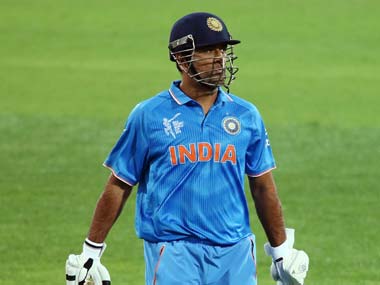As Michael Clarke and Steve Smith took their places at the post-match press conference, highlights of the second semi-final started playing on screen. Clarke pointed to Smith and said, “Kohli’s wicket, big moment!” Smith just nodded in agreement. When Virat Kohli skied that delivery off Mitchell Johnson, this second semi-final turned in Australia’s favour. The overs kept counting down. The required run-rate started a steep climb. Yet the average Indian fan did not lose hope because India still had MS Dhoni. [caption id=“attachment_2176829” align=“alignleft” width=“380”]  File picture of MS Dhoni. Getty[/caption] At 108 for 4, the match was dead and buried. This target was beyond India. Dhoni knew it. Ajinkya Rahane scratched around and the skipper ran his singles and twos. They put on 70 runs for the fifth wicket at a decent clip of 5.25 per over. Everyone anticipated an attack soon, only it never came. “Our lower order has not been contributing much,” Dhoni said at the press conference. “So there is always that danger of going too early and losing wickets. So you have to take a risk at the right time. Maybe we went at it too late, but, if my partnership with Ajinkya hadn’t worked out, we would have been bowled out for 140 or 150.” Unaware of these calculations in Dhoni’s mind, a plethora of prayers went around the Sydney Cricket Ground. Glued to their screens elsewhere, others hoped too. Two sixes off Shane Watson in the 42nd over brought them all to their feet, in unison, never mind the distance between Sydney and Delhi. Such is the swagger Dhoni brings to the crease that Indian fans have the audacity to hope even when the chips are down. And Dhoni has turned up trumps more times than anyone can remember. He could not on Thursday, however. With his run-out, India’s reign as World Champions was over. Every fan watching hoped it wouldn’t be the last time Dhoni walked back to the dressing room. The retirement question came up at the press conference. Dhoni answered it by saying he would consider his options after the World T20 in India next year and who knows, might be around for the 2019 World Cup. India should breathe a sigh of relief. While Dhoni has stepped away from Test cricket, his leadership has been central to this reversal of Indian fortunes in the limited-overs arena. It isn’t all about the way he has led on the field either. In the first match against Pakistan, Dhoni was asked what the Indian players did during their ten-day break on-tour. His reply: “They were given a free pass. Don’t murder anyone, rest do what you want.” Dhoni’s ability to switch off when the game is over is perhaps more remarkable than his calmness while finishing off matches. And it has rubbed off on his teammates, all of them finding enough recreation Down Under these past four months. The recovery and regeneration process of the Indian team, after losses in the Test series and ensuing tri-series, has been admirable. It has the Dhoni seal all over it. Perhaps in this role of elderly statesman to a young, blossoming team, a new element of Dhoni’s batting emerged. Thanks to the ICC’s rule changes, India needed to play with six batsmen and five bowlers. It meant Dhoni needed to bat at six, even as the team struggled to find an optimal choice to bat at No. 4. Experimentation ranged from Rahane to Suresh Raina, back to Yuvraj Singh, and then Rahane again, with Rayudu as back-up. The position needed someone who could accumulate runs where necessary but also go ballistic when needed. On paper, Dhoni was perfectly suited to the job but avoided it. This responsibility of batting at No. 6, of connecting the middle and lower orders and shepherding the innings at the death, settled more comfortably on his broad shoulders. “It was a conscious attempt to make sure that all these youngsters bat up the order,” Dhoni said with a smile. “Apart from that, what people think about me as a player doesn’t really matter because I play for the enjoyment of the game. I don’t really have to do anything with the amount of runs I have scored. The day I pack my bags, I will be happy on my bike” Dhoni has been the bridge between a golden generation that ended up winning the crown in 2011 and a youth brigade that reached the semi-finals in 2015. He is the last romantic connect to a bygone era and also an inspiration for the one to come - those who will look to regain the World Cup in four years’ time.
Dhoni has been the bridge between a golden generation that ended up winning the crown in 2011 and a youth brigade that reached the semi-finals in 2015.
Advertisement
End of Article


)

)
)
)
)
)
)
)
)



